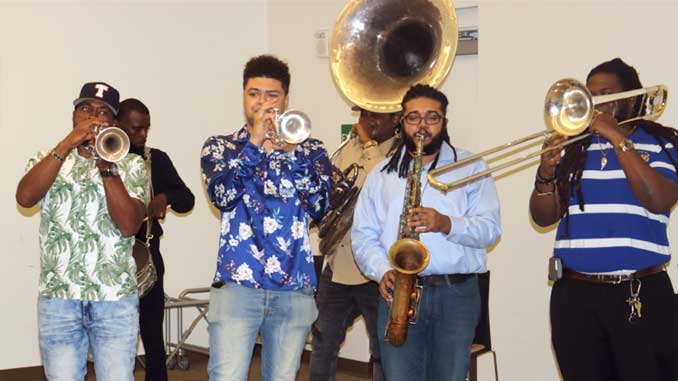
Story and Photos by Nigell Moses Data News Weekly Contributor
For visitors in New Orleans, second lining is for entertainment, a once a year Mardi Gras event, but for New Orleanians, it’s a lifestyle. That was the essence of a conversation around the 70-minute documentary film Buckjumping, screening.
The film was produced by North Carolina native and New Orleans-based filmmaker, Lily Keber, whose production team comprised of New Orleans natives Allendra Freeman and Zac Manuel.
“I wanted to focus on the people behind the scenes. The second liners, not just in the street, but the people who are putting the culture and the intellectual capital into making these traditions exist,” said Keber at a public lecture where she brought some of the performers in the 2018 film.
Keber won the 2013 Oxford American Award for Best Southern Film and the Louisiana Endowment for the Humanities’ Documentary of the Year. Keber is best known for her debut film, Bayou Maharajah in 2013, which is about the life of the late James Booker, a legendary New Orleans pianist.
The audience who attended the screening on Xavier University’s campus learned about social aid and pleasure clubs like The Nine Times, Pigeon Town Steppers and Lady Buckjumpers. Pleasure and social aid club members shared first-hand the multiple meanings of what a second line is. Second lining is more than music and dance, they said, describing it as a state of mind and about being a free spirit.
Buckjumping, they explained, is a dance that is essential to second lines which includes a jazz band, distinct garments, and intricate footwork. It is also a way to escape the tribulations of everyday life, and is a dance of liberation, the club members said.
“We deal with so many things. You dance your troubles away,” said New Orleans Rap Artist Mia Young, who goes by Mia X, in the film.
Second line parades celebrate the living and the deceased. The film captured a funeral showing family members buckjumping in the streets and on top of cars, memorializing the life of their beloved relative.
“What would be a better way to send somebody off than a jazz funeral? That is so New Orleans,” said Byron “Mannie Fresh” Thomas in the film. Thomas is a New Orleans native producer and recording artist. “Without that, it wouldn’t even feel right,” he added.
The film gave insights on the rich history and origin of second lining. It credited these Carnival traditions as beginning in the neighborhoods and communities of Black people. Second lines are held on Sundays because on this day, slave masters brought their slaves to the French Quarters in Congo Square, the film outlined. Slaves collaborated, sharing their knowledge of different instruments and sounds, creating today’s brass and jazz bands.
The film also showcased how Native Americans played a vital role in the history of second lining and Mardi Gras Indian Culture. It recounts how Native Americans assisted enslaved African Americans to freedom.
“We mask as Native Americans to pay homage to Native Americans who helped the slaves, when they were running away,” said Irving ‘Honey’ Banister in the film. Banister is a Creole Wild West Big Chief and singer for the Cha Wa Nation in the film. “It’s not tribute it’s homage,” Banister added.
Keber acknowledged her position as an observer while entering the spaces and communities she filmed. She talked about being a participant observer and allowing the communities featured within the film to use their agency and voices.
“I let the people direct me on what is most important to them, rather than coming with a predetermined idea,” Keber said.
Buckjumping, the performers said, is a form of resistance against the oppression of slavery and Jim Crow segregation. It is an act that releases the idea to conform to power structures and demands of society, they added.
“We talk about this resistance for Black men during that time where they could have been lynched, killed, disappeared, or incarcerated.
Then they decide that they are going to stand in the street and defy a police officer and say, ‘I’m a big chief,’” said Ausettua Amor Amenkum, the Big Queen of the Washitaw Nation Mardi Gras Indian Tribe. “That is definitely an act of resistance,” Amenkum said in the discussion.
Recommended For You.



Be the first to comment